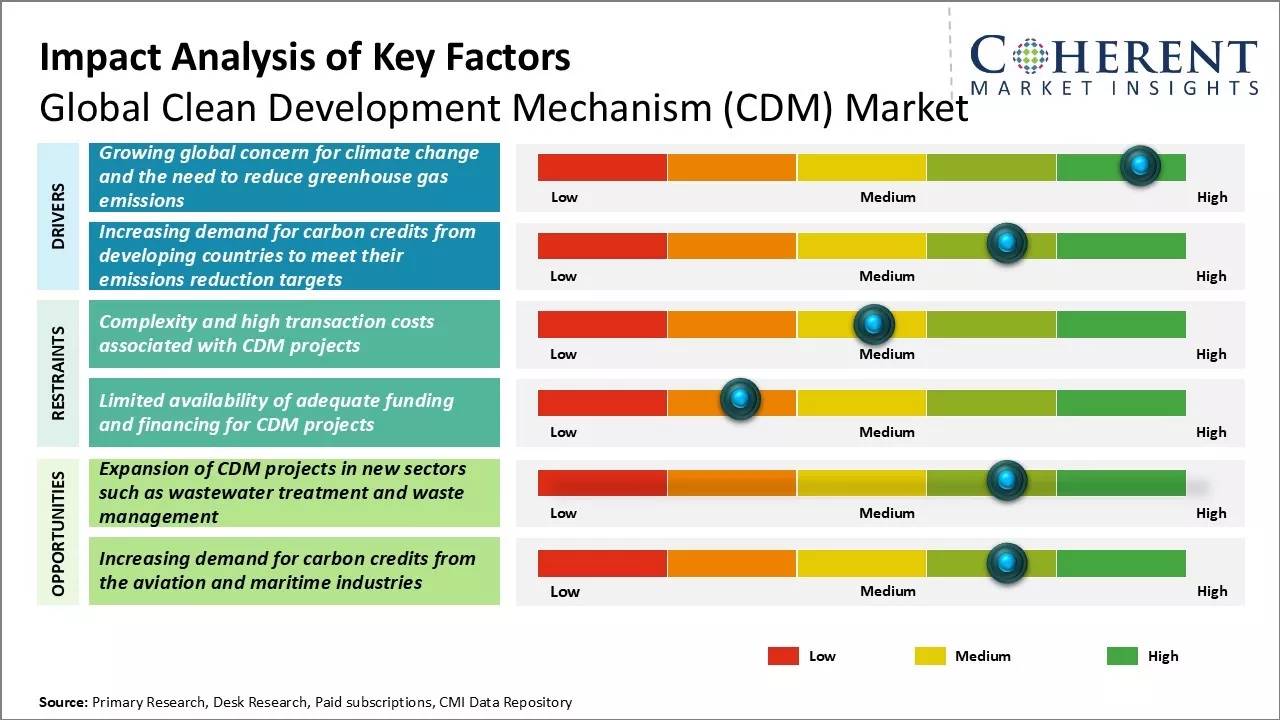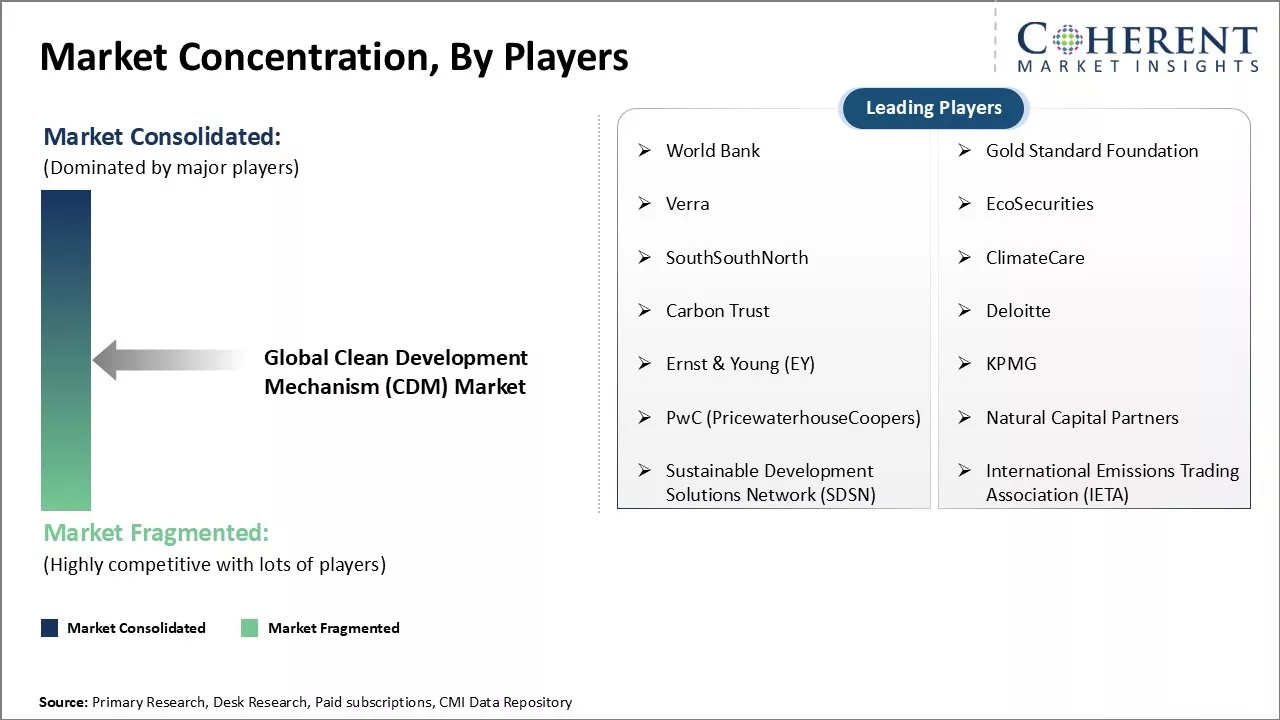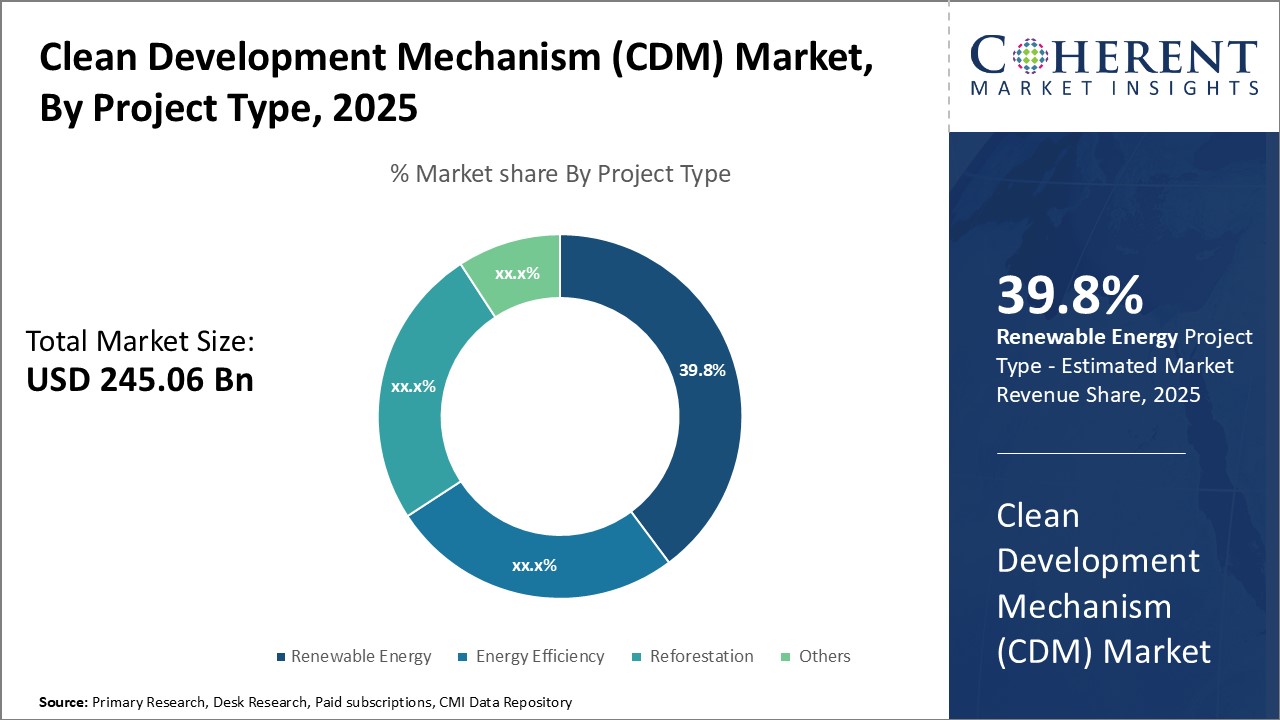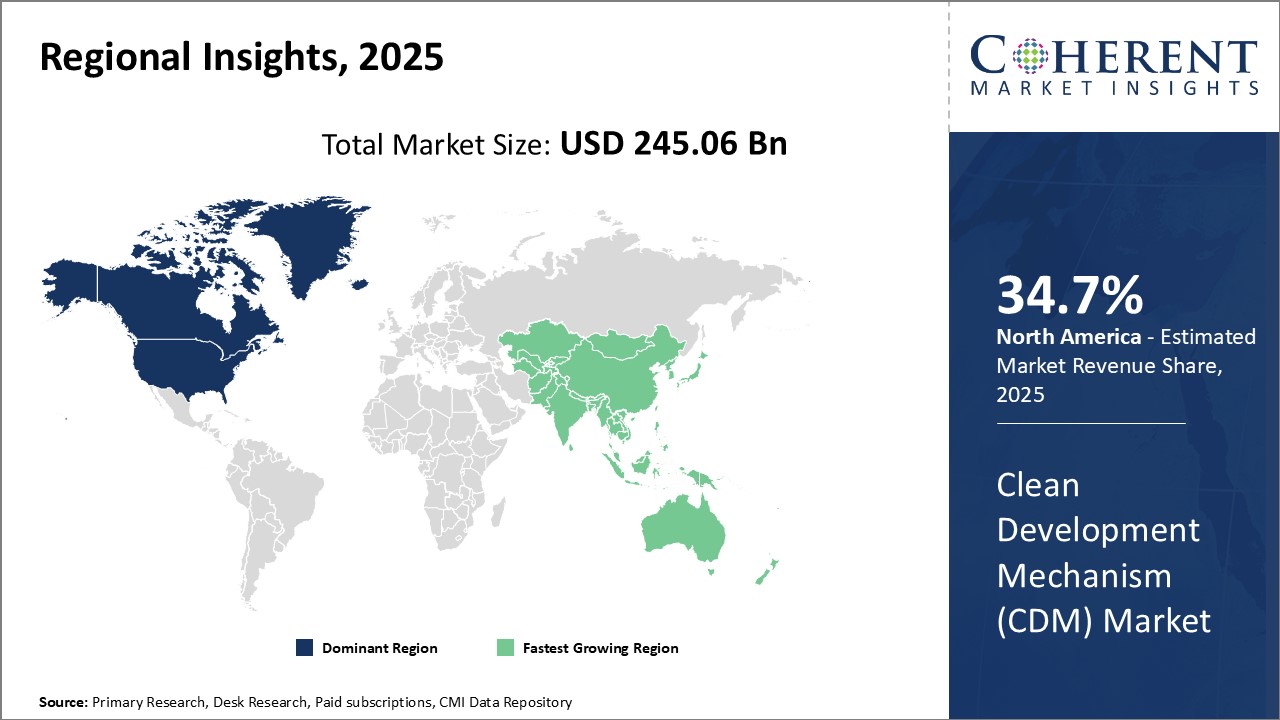Clean Development Mechanism (CDM) Market Size and Trends
The global Clean Development Mechanism (CDM) market is estimated to be valued at US$ 245.06 Bn in 2025 and is expected to reach US$ 439.71 Bn by 2032, exhibiting a compound annual growth rate (CAGR) of 8.7% from 2025 to 2032.

Discover market dynamics shaping the industry: Download Free Sample
Growing environmental concerns and emphasis on the adoption of clean energy are expected to drive the demand for carbon reduction programs. Many countries globally have pledged to follow the Paris Agreement and reduce their carbon footprint. This is increasing the demand for energy efficient technologies and renewable energy. The corporations are also investing increasingly in acquiring carbon credits to meet their internal carbon reduction targets. Various support mechanisms by regulatory bodies like tax benefits and carbon trading are further boosting the growth of Clean Development Mechanism (CDM) market. However, concerns over additional costs and lack of standardized rules for carbon credits can hamper the market growth. But overall, the Clean Development Mechanism (CDM) market is well positioned to grow at a steady rate during the forecast period due to the growing need for sustainability across various industries.
Growing global concern for climate change and the need to reduce greenhouse gas emissions
With the growing impacts of climate change becoming more apparent each year, there is an increased focus on reducing greenhouse gas emissions from governments and corporations around the world. Climate scientists warn that global warming needs to be limited to well below 2°C to avoid the worst effects of climate change such as more frequent extreme weather events, rising sea levels, and damage to agriculture and wildlife. It is widely recognized that collective global action is required to transition to a low carbon economy and meet the emissions reduction targets set out in the Paris Agreement.
The effects of climate change are already being felt through rising temperatures, melting glaciers and sea ice, more intense heatwaves, and forest fires. Communities around the world are experiencing disruption to food production and water security due to changing weather patterns. As the impacts grow increasingly difficult to ignore, public concern over climate change is rising significantly. Younger generations especially are demanding urgent action from governments and companies on environmental issues.
To achieve the goals of the Paris Agreement, every sector of the global economy needs to reduce their carbon footprint. While renewable energy is being deployed at scale, lowering emissions from heavy industries such as cement, steel, and chemicals is extremely challenging using existing technologies. The CDM provides a proven mechanism to generate finance for low carbon projects in these sectors and unlock affordable solutions through overseas collaboration and investment. By facilitating technology transfer between developed and developing nations, the CDM can help accelerate the innovation required to decarbonize the industry globally. With climate change presenting a critical long-term threat, the need for cooperative international frameworks like the CDM will continue growing in the coming decades.
Market Concentration and Competitive Landscape

Get actionable strategies to beat competition: Download Free Sample
Increasing demand for carbon credits from developing countries to meet their emissions reduction targets
Developing countries are increasingly implementing ambitious climate change policies and committing to economy-wide emissions targets under the Paris Agreement. However, achieving major reductions presents a substantial challenge for nations still undergoing rapid industrialization and economic growth. Accessing finance through carbon markets like the CDM plays an important role in helping emerging economies meet their emissions goals in a cost-effective way, while also achieving sustainable development.
Many developing countries see carbon trading as an opportunity to attract green investment towards renewable energy, energy efficiency and other low carbon development projects. The carbon credits generated can then be used domestically by industrial facilities to comply with emissions regulations, or sold internationally to offset emissions in other parts of the world.
As more developing economies put a price on carbon and strengthen their climate policies in line with their Paris pledges, the pool of potential buyers of carbon credits from the CDM is set to expand rapidly in the coming decade. Analysis shows meeting the conditional NDC targets of countries could generate demand for billions of additional carbon credits annually by 2030. With early adoption of green growth strategies, nations see an opportunity to leapfrog heavily polluting phases of development and integrate low carbon solutions into long term infrastructure planning. A healthy global carbon market with liquidity provided by players like the EU Emissions Trading System is critical for developing countries to cost effectively achieve their climate and economic goals through mechanisms such as the CDM.
Key Takeaways from Analyst:
The global Clean Development Mechanism (CDM) market remains an important mechanism to drive sustainable development and combat climate change. Key drivers for CDM project development include compliance with emissions reduction targets under the Kyoto Protocol and voluntary carbon markets. Emerging economies with higher emissions growth present significant opportunities for carbon offsetting.
China has dominated the market as the largest source of CDM projects due to its sizable industrial base and emissions. However, other nations are pushing reforms to attract more projects and foreign investment. Development has been constrained by lengthy UN approval procedures which many project developers see as a restraint.
Renewable energy projects especially involving wind, solar, and hydro power have been the fastest segment to utilize the CDM framework and are expected to lead future growth. Meanwhile, end of the Kyoto Protocol's first commitment period poses uncertainty unless nations agree to extend compliance periods. Ambiguous international climate change policies also continue to hinder long-term planning for the market.
Overall, the CDM presents a cost-effective means to support low-carbon investment in the developing world. While China may gradually lose share to other emerging nations with improving frameworks, the renewables sector is primed to leverage the mechanism if long-term policy visibility can be enhanced.
Market Challenges: Complexity and high transaction costs associated with CDM projects
The complexity involved in the CDM project cycle and meeting various regulatory requirements is one of the major challenges facing the global Clean Development Mechanism (CDM) market. Getting a project approved under the CDM is a lengthy process which requires extensive documentation and validation of the project's additionality from an independent third party. This results in high transaction costs for project developers to cover expenses towards formulation of Project Design Documents, engagement of Designated Operational Entities for validation and verification, establishing Monitoring and evaluation plans, etc. The costs escalate further for small scale projects due to diseconomies of scale. Moreover, uncertainty in the carbon credit prices post 2012 when the first commitment period of Kyoto Protocol ends, discourage many investors who are hesitant to invest in long gestation CDM projects under the current market conditions. High costs and complexity pose barriers, especially for harnessing emission reduction potential from small developing countries and project types.
Market Opportunities: Expansion of CDM projects in new sectors such as wastewater treatment and waste management
There exists a significant market opportunity for the growth of CDM projects in sectors such as wastewater treatment and waste management. These sectors were often not prioritized in the initial Clean Development Mechanism (CDM) market phase. However, they offer sizable mitigation potential. Waste management projects such as recovery and combustion of landfill gas, composting of organic waste and wastewater treatment projects through technologies like biogas capture offer new avenues for carbon credits. Many cities across developing nations are facing challenges of growing waste and have an unmet demand for scientific waste treatment solutions. CDM could facilitate environmentally-sound waste and wastewater projects by channelizing carbon financing to them. Global demand for credits from non-traditional project types would encourage project development even in small communities. This will also enhance sustainable development benefits of CDM.

Discover high revenue pocket segments and roadmap to it: Download Free Sample
Insights By Project Type - Diversification of Renewable Energy Sources Fuels Growth
In terms of project type, renewable energy is expected to contribute 39.8% share of the market in 2025 owing to the diversification of energy sources. Renewable energy relies on power generation from natural sources such as wind, solar, hydro and biomass that replenish themselves naturally. This gives renewable energy an advantage over fossil fuels that are exhaustible and cause pollution during combustion. Governments and private entities across the world are actively promoting greater use and development of renewable energy to reduce dependence on imported fossil fuels and minimize carbon emissions.
Within renewable energy, solar and wind power have seen tremendous growth in recent years. Technological advancements have made solar panels and wind turbines more efficient and cost effective. Public-private partnerships are setting up large-scale solar and wind farms across lands and oceans. Residential solar panel installations are rising rapidly due to lower costs and subsidies on such green investments. Off-grid solar solutions are reaching remote regions without access to electricity. Meanwhile, continuous research is exploring new ocean energy technologies such as ocean thermal, tidal and wave energy conversion. Waste-to-energy through bio methanation and municipal solid waste incineration is gaining prominence as well. The diversification of renewable energy sources ensures stable long-term growth prospects for the overall renewable energy segment.
Insights By Project Scale - Capital Intensive Nature Concentrates Projects at Large-scale
In terms of project scale, large-scale is expected to contribute 56.1% share of the market in 2025 owing to the capital-intensive nature of CDM projects. Setting up renewable energy power plants, installing highly advanced emission reduction technologies, establishing forestation activities require massive investments that most small entities cannot afford. Large corporations and government-led initiatives therefore dominate the CDM landscape. They have the necessary financial resources and risk appetite to undertake projects at utility-scale.
Large-scale projects also benefit from economies of scale in terms of lower per unit costs. Their bigger size allows for more efficient use of specialized machinery, equipment, and automated processes during construction and operations. This delivers higher emissions reductions at reduced costs. Financiers prefer funding large ventures as they offer more predictable, sizeable returns on investment compared to smaller projects with uncertain outcomes. Moreover, the CDM’s elaborate approval process becomes more manageable for proponents of large undertakings who can dedicate sizable professional teams for validation, registration and verification tasks. For all these reasons, large-scale projects have proved more attractive to major players in the CDM business.
Insights By End-use Industry - Compliance Needs Drive Investments in Power Sector
In terms of end-use industry, power and energy is expected to contribute 41.9% share of the market in 2025 as it faces some of the most stringent compliance needs. Power generation accounts for over a quarter of global greenhouse gas emissions mainly due to the dominance of coal-fired plants. With growing pressure to decarbonize the energy sector and meet international climate pledges, governments and utilities are allocating huge capital towards transitioning to cleaner sources. Carbon credits generated from CDM projects help enhance the green credentials of power companies in a cost-effective manner, allowing them to continue operations within a regulated emissions cap.
The power sector is ideal for CDM deployment as it allows for large-scale installation of renewable assets like solar parks, wind farms and hydro stations to diversify the generation mix. Also, emission reduction projects involving supercritical boiler retrofits, efficient coal combustion, gas pipeline leak capture have found extensive application in thermal plants. Waste heat recovery, intelligent grid technologies, afforestation of degraded land for carbon sequestration are other avenues explored. Investments into innovative power CDM projects not only satisfy regulatory norms but position companies as sustainability leaders with a better ESG risk profile appealing to environmentally-conscious investors as well. This drives the leading position of the power industry within the Clean Development Mechanism (CDM) market.
Regional Insights

Need a Different Region or Segment? Download Free Sample
North America is expected to dominate the global Clean Development Mechanism (CDM) market, accounting for a significant share of 34.7% in 2025. The region's dominance can be attributed to the increasing adoption of renewable energy sources, stringent environmental regulations, and the presence of major players driving the development of CDM projects. The U.S. and Canada are the key contributors to the North American Clean Development Mechanism (CDM) market, with the U.S. being one of the largest participants in the global Clean Development Mechanism (CDM) market.
The Asia Pacific region is expected to experience the fastest growth in the Clean Development Mechanism (CDM) market during the forecast period. Rapid industrialization, rising energy demand, and the need to address climate change have created a favorable environment for the adoption of CDM projects in countries like China, India, and Japan. The region's growing focus on sustainable development and the implementation of policies to promote clean energy technologies are expected to drive the expansion of the Clean Development Mechanism (CDM) market in Asia Pacific.
Overall, the global Clean Development Mechanism (CDM) market is driven by the increasing focus on sustainable development, the need to mitigate the impacts of climate change, and the growing adoption of clean energy technologies across various regions. The market is expected to continue its expansion, with North America maintaining its dominant position, Asia Pacific experiencing rapid growth, and other regions contributing to the overall market development.
Market Report Scope
Clean Development Mechanism (CDM) Market Report Coverage
| Report Coverage | Details | ||
|---|---|---|---|
| Base Year: | 2024 | Market Size in 2025: | USD 245.06 Bn |
| Historical Data for: | 2020 To 2024 | Forecast Period: | 2025 To 2032 |
| Forecast Period 2025 to 2032 CAGR: | 8.7% | 2032 Value Projection: | USD 439.71 Bn |
| Geographies covered: |
|
||
| Segments covered: |
|
||
| Companies covered: |
World Bank, Gold Standard Foundation, Verra, EcoSecurities, SouthSouthNorth, ClimateCare, Carbon Trust, Deloitte, Ernst & Young (EY), KPMG, PwC (PricewaterhouseCoopers), Natural Capital Partners, Sustainable Development Solutions Network (SDSN), and International Emissions Trading Association (IETA) |
||
| Growth Drivers: |
|
||
| Restraints & Challenges: |
|
||
Uncover macros and micros vetted on 75+ parameters: Get instant access to report
Clean Development Mechanism (CDM) Industry News
- In March 2024, the Clean Development Mechanism (CDM) under the Kyoto Protocol, recognized as the world's first international carbon finance scheme, allows companies to acquire tradeable certified emission reduction credits by investing in energy conservation and renewable energy projects in developing countries. Despite its initial success, the mechanism faced a collapse during the 'carbon panic' of 2012. This analysis examines the reasons behind the CDM's downfall and its implications for negotiations surrounding the Paris Agreement. Although the mechanism has seen a revival due to renewed interest from the U.S. and developing nations, the structural vulnerabilities of carbon financing persist, making it susceptible to future panics.
*Definition: The Global Clean Development Mechanism (CDM) market involves projects that reduce emissions of greenhouse gases in developing countries while contributing to their sustainable development. Through the CDM, certified emission reduction units are generated from emissions-saving projects which can then be traded in emission trading schemes. This allows developed countries that have greenhouse gas emission reduction targets to meet their commitments in a cost-effective way while supporting sustainable development.
Market Segmentation
- Project Type Insights (Revenue, US$ Bn, 2020 - 2032)
-
- Renewable Energy
- Energy Efficiency
- Reforestation
- Others
- Project Scale Insights (Revenue, US$ Bn, 2020 - 2032)
-
- Large-scale
- Small-scale
- End-use Industry Insights (Revenue, US$ Bn, 2020 - 2032)
-
- Power and Energy
- Manufacturing
- Waste Management
- Others
- Regional Insights (Revenue, US$ Bn, 2020 - 2032)
-
- North America
- U.S.
- Canada
- Latin America
- Brazil
- Argentina
- Mexico
- Rest of Latin America
- Europe
- Germany
- U.K.
- Spain
- France
- Italy
- Russia
- Rest of Europe
- Asia Pacific
- China
- India
- Japan
- Australia
- South Korea
- ASEAN
- Rest of Asia Pacific
- Middle East
- GCC Countries
- Israel
- Rest of Middle East
- Africa
- South Africa
- North Africa
- Central Africa
- North America
- Key Players Insights
- World Bank
- Gold Standard Foundation
- Verra
- EcoSecurities
- SouthSouthNorth
- ClimateCare
- Carbon Trust
- Deloitte
- Ernst & Young (EY)
- KPMG
- PwC (PricewaterhouseCoopers)
- Natural Capital Partners
- Sustainable Development Solutions Network (SDSN)
- International Emissions Trading Association (IETA)
Share
Share
About Author
Ankur Rai is a Research Consultant with over 5 years of experience in handling consulting and syndicated reports across diverse sectors. He manages consulting and market research projects centered on go-to-market strategy, opportunity analysis, competitive landscape, and market size estimation and forecasting. He also advises clients on identifying and targeting absolute opportunities to penetrate untapped markets.
Missing comfort of reading report in your local language? Find your preferred language :
Transform your Strategy with Exclusive Trending Reports :
Frequently Asked Questions
EXISTING CLIENTELE
Joining thousands of companies around the world committed to making the Excellent Business Solutions.
View All Our Clients
